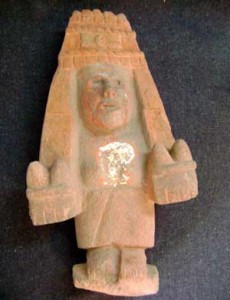- Tofu, anyone?
- Plumcot, anyone?
- Guerrilla gardening, everyone!
- Green Revolution breadbasket drying up. ICRISAT has the answer. Well, sort of.
- BBC has a different answer. Trees can keep people alive in times of drought.
- More semi-naked chicks, this time in South Africa.
- Naked or otherwise, eat them to save them, with the American Livestock Breeds Conservancy.
Nibbles: Seed Conference, High carotenoid bananas, DIVA-GIS, Protected area map, Pulse domestication, Food policy, Torreya rewilding
- The 2nd World Seed Conference is coming up soon.
- Orange bananas make it big in the Solomon Islands. Thanks, Lois.
- DIVA-GIS website gets a makeover. Watch out for the blog.
- Global protected areas map mashed up.
- Dorian Fuller blogs lentil and bean domestication.
- Bookforum.com does food.
- While people discuss the pros and cons of assisted migration, one group has actually gone out and done it.
Chicomecoatl the Maize Goddess restored
Nibbles: Cacao, Soil mapping, Rice terraces, Maize, Cereus
- “USDA’s Bourlaug International Science Fellows Program has partnered with non-profit and for-profit organizations to identify new agricultural techniques for cocoa cultivation and to control cocoa diseases.” And do some conservation and breeding, surely.
- Big shots call for a decent global digital soil map. Seconded.
- Cool photos of rice agricultural landscapes.
- Roasting maize, Mexico style. Oh yeah, there’s also a nifty new maize mapping population out.
- Peruvian apple cactus doing just fine in Israel.
Nibbles: Urban bees, Borlaug, Cotton, Income, Mammals, Human disease, Caribou, Chestnut, IRRI
- There are 227 bee species in New York City. Damn! But not enough known about the work they (and other pollinators) do in natural ecosystems, alas.
- Borlaug home to be National Historic Site?
- Archaeobotanist tackles Old World cotton.
- FAO suggests ways that small farmers can earn more. Various agrobiodiversity options.
- About 400 new mammal species discovered since 1993 (not 2005 as in the NY Times piece). Almost a 10% increase. Incredible. Who knew.
- But how many of them will give you nasty diseases?
- The caribou wont, I don’t think. And by the way, its recent decline is cyclical, so chill.
- Saving the American chestnut through sex. Via the new NWFP Digest.
- “The best thing IRRI can do for rice is to close down and give the seeds it has collected back to the farmers.” Yikes, easy, tiger! Via.
